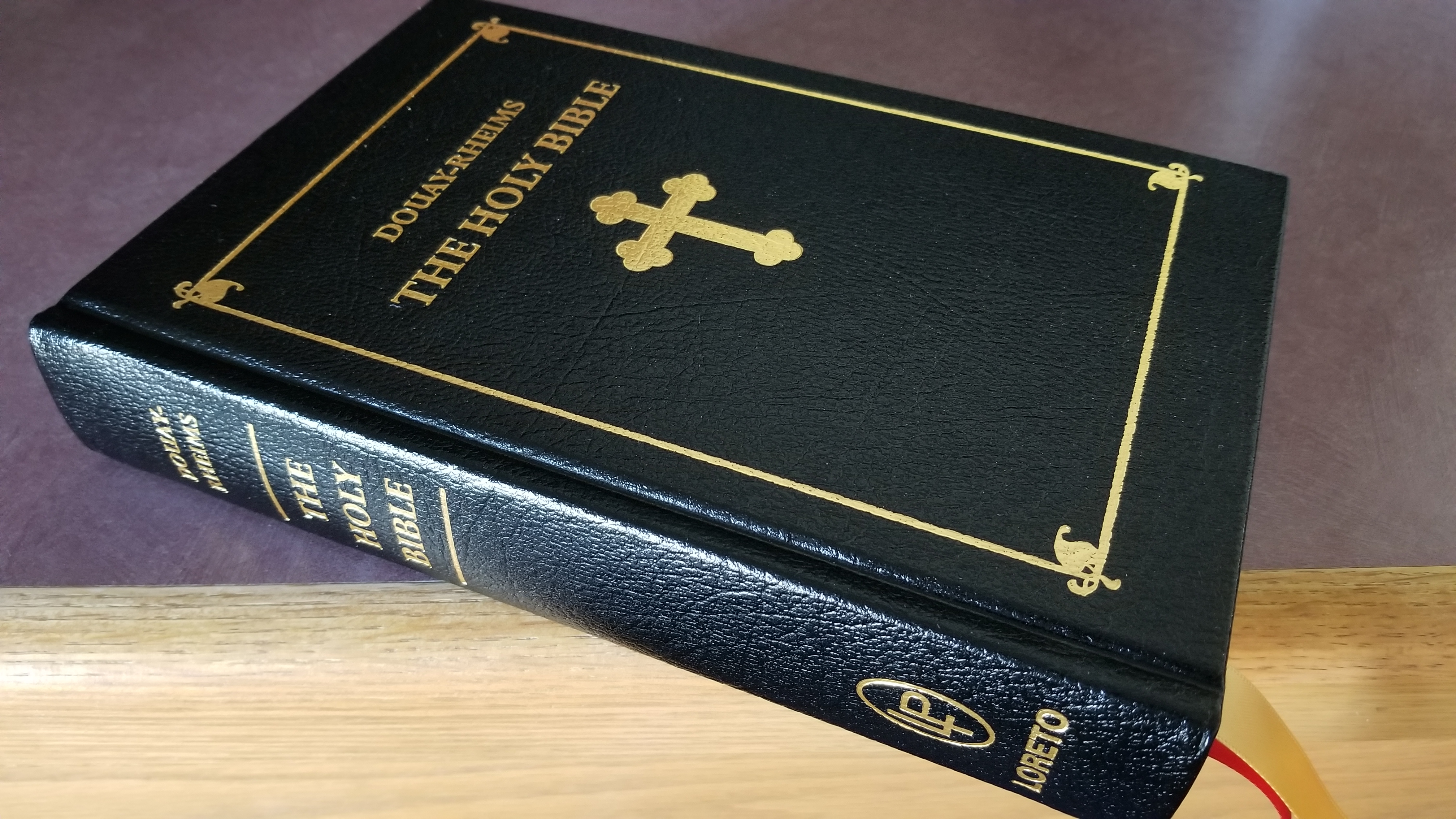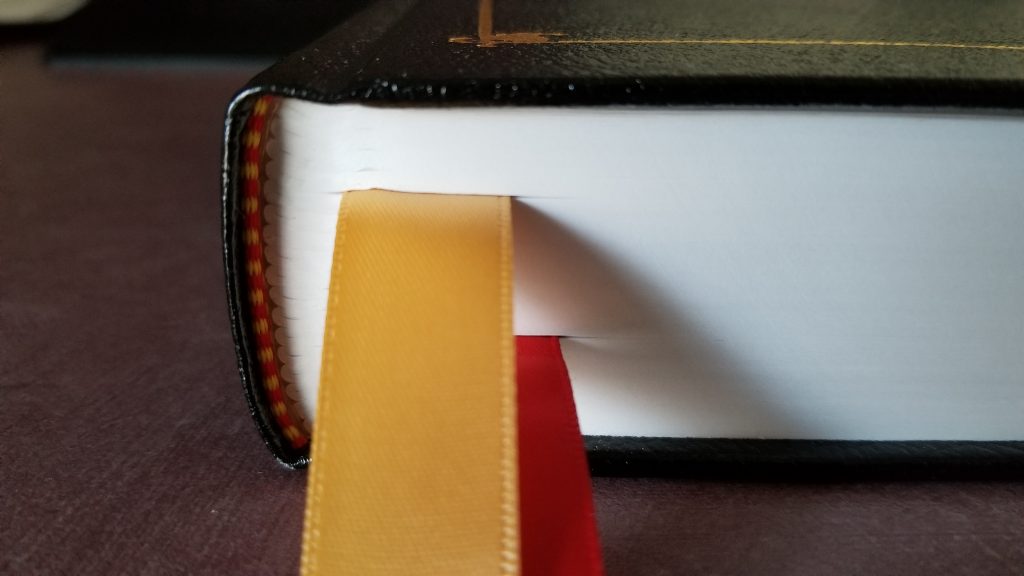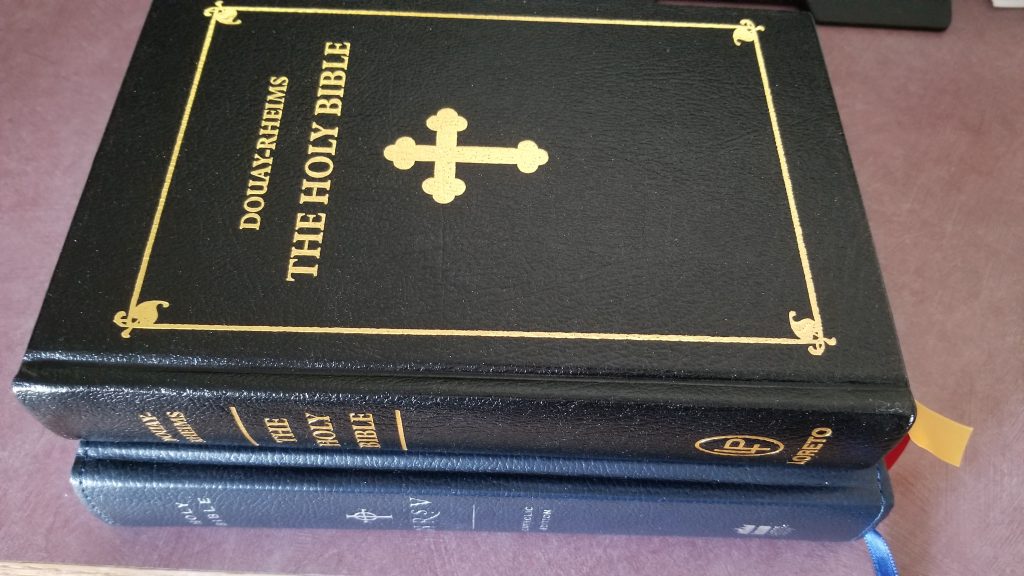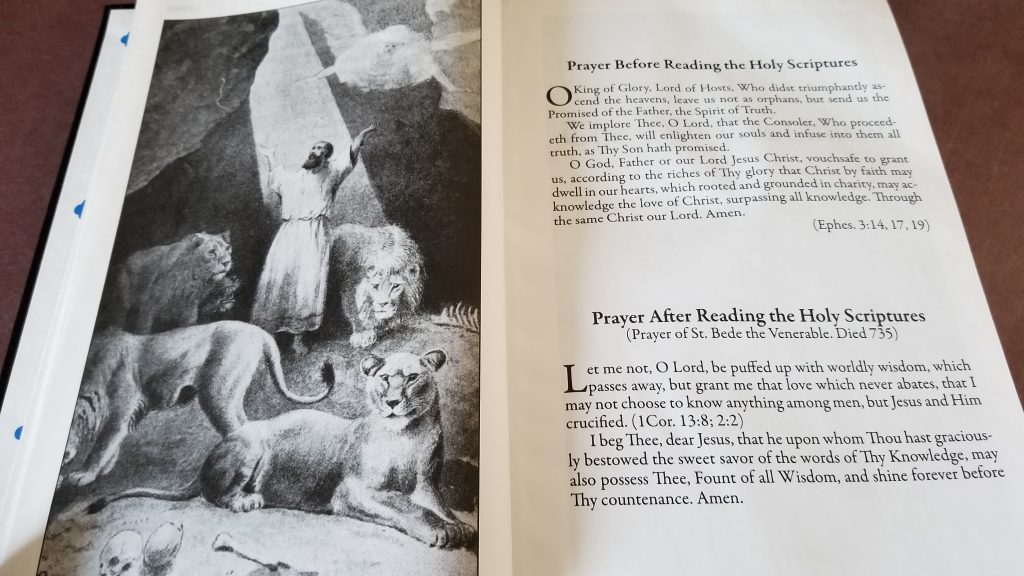
Last year, Timothy posted a review of the hardcover Douay-Rheims Bible published by Loreto Publications. As Timothy mentioned in his review, Loreto has been working on a new typesetting for their Douay-Rheims, and it is now available in print! Loreto kindly shipped me a review copy.
The overall construction of this bible is very similar to the previous edition. It features a hardcover wrapped in bonded leather, a sewn binding, two high-quality ribbon markers that are 5/8-inch (1.6 cm) wide, and Loreto’s unique endpapers emblazoned with blue crosses.



I enjoy the feel of this bible in the hand. It’s very close to a perfect size for me, measuring 6 3/16 X 9 1/4 inches (15.8 X 23.5 cm). It has a slightly smaller footprint than the HarperOne NRSV Catholic Edition hardcover, as shown below:

The binding is also very usable out of the box. It easily opens flat throughout the vast majority of the bible with minimal stiffness. Near the beginning and ending (around the first and last 50 pages), it will require a bit of use before it will effortlessly lie flat, but this is very normal, especially for a new bible.
The new typesetting is a significant improvement over the older editions of this bible. Loreto reports that the font is larger, and I can confirm that it is large, bold, and very readable. It is significantly larger than the 8 pt font in my Cambridge hardcover REB. I would estimate it is at least a 10 pt size. The pages also have a cleaner look compared to the old edition with its line dividers between the columns and its antiquated font which looked like a newspaper from the 1800s (see Timothy’s review for a few photos of the old edition).


The text is line-matched, and the ghosting is very minimal. In fact, the ghosting is surprisingly minimal in light of how bold the text is. I think readers who have trouble with small bible font or who long for a bible with darker and bolder letters will love this edition. I’m disappointed to see that it retains the verse-by-verse format (with each verse beginning on a new line) instead of a paragraph format, but this is common in Douay-Rheims editions and other older bibles like the King James Version.

The bible features several illustrations, a few prayers, and the encyclical Providentissimus Deus by Leo XIII. There is a section between the Old Testament and New Testament that includes an index of references and a chronological table of important events surrounding the Old and New Testaments.
For anyone who is currently looking for a Douay-Rheims edition, or who prefers the Douay-Rheims, I can whole-heartedly recommend this new edition from Loreto. It’s very nicely done with few shortcomings.
Ah! Gorgeous, simple gorgeous!
The verse-by-verse formatting actually makes me feel a little nostalgic when I look at it, back when I read the KJV nearly exclusively. 🙂
And to put vanity on vanity, I find myself really liking that calligraphic “A” in the picture showing off Exodus. I really appreciate old-style aesthetics like that.
Beautiful. Needs room for notes in the margins and a leather binding. Then ,I would buy to use and pass on.
I have the older edition, looks like this is a significant improvement over that one. May have to consider upgrading.
Omg that type is waaaaaaay better than before! I remember looking at this DR a long time ago for the price and the type of cover but was heavily disappointed in the type. Now I can reconsider it.
Where I can find this Bible in Europe? I like it, but purchasing from Us is too expensive. Do you think they will sell it on Amazon webstores in Europe?
Mark, I’m not sure if Loreto will be selling this edition through any European outlets. Does anyone else have insight on this? If nothing else, I would suggest contacting Lorteo customer service through their website to ask about this. Their contact page is http://loretopubs.org/contact-us.html
Thank you for your answer. I wrote them but they did not reply, so I think I will read DR in ebook. Your blog is very interesting.
Which is, in your opinion, the best edition of the DR Bible?
The DR here is actually the Challoner version. It is a good read; however, to me it is the sheet metal of the King James Version that has been pounded into the shape of the Latin Clementine Vulgate. This doesn’t make it a bad translation as there is greatness in the KJV; however its connection to the Doughy-Rheims original is not significant. I have read only portions of the New Testament of the original. In the context of a Bible Study (1 Corinthians) ,I found the original to be not just a translation but a significant and valuable commentary. Clearly, when reading the notes, you can see that it is a counterreformation document; as it was intended to be an evangelical tool for the brave priests, who often ended up being, hung drawn and quartered, who went to England with goal of returning England to its Catholic roots. I do not believe that the original DR was printed in any volume; thus I think its actual significance may be overrated. That being said; with its notes and commentary I think it is a great contemporary tool, among many ,to be used in a serious Bible Study. Facsimile copies of the complete original DR are very expensive. However, there are a number available online such as: http://catholicresourcepage.blogspot.com/2015/08/the-original-douay-rheims-bible-pre.html. So why is this Challoner version important? It is important because there was no Catholic Bible for English only speakers available until the Challoner version was published in 1750. The original DR appears to have been out-of-print for many years (perhaps more than 100). It wasn’t until the Jerusalem Bible in 1966 and the New American/Confraternity Bible completed in 1970 that a modern English language Bible (Knox Bible would be an exception) was mass produced, and ,used in the liturgy of the mass. Note: Knox was approved for liturgical use; but to my knowledge only in the Liturgy of the Hours. My bottom line is that all Bible Translations are to a degree commentaries; and, nearly all shed light (from the Holy Spirit) on the original writings. However, the intensity of the light varies from translation to translation. I think, in the case of the DR, that it is more nostalgia that drives its somewhat meager publication figures (hence its expense.) However, as I always try to remember when asked what is the best translation, I should reply that the best translation is the one you want to read.
The Knox translation is not in modern English, it is in archaic English in ‘On Englishing the Bible’ he complains about this, but his mandate was to use archaic English, and he followed his mandate. The first Catholic Bible in modern English appears to be the Jerusalem Bible.
Thanks for answering that question. I was wondering.
ARE there any print versions of the original DRB in modern typesetting?
http://realdouayrheims.com
Those ribbons are enormous.
Best bible translation: Jerusalem Bible.
Adrian, I have a copy of it but while I do like it, it is clearly not the best as it is a paraphrase. The best out there is, so far, the RSVCE in my humble opinion.
One change in this new type-setting is the spellings have changed from British to American e.g Saviour becomes Savior, honour becomes honor etc. I prefer the British spelling of Saviour with 7 letters…won’t be a big deal to most people though. Just something I observed in comparing it to the old type-setting.
Have the spellings of proper nouns been changed to match modern spellings (de-Latinized you could say), i.e. Noah vs. Noe, etc?
I have this bible, and Noe is written. Highly recommend, the font and general layout makes me want to keep reading! God bless you!
Note- this bible does not have a sewn binding. Look closely; you can see the glue. It appears to be very well-done and sturdy, just not sewn.
Peace.
Hi Douglas,
I can confirm that the binding on this bible is sewn. Most modern sewn bindings are constructed by sewing the signatures together and then gluing the spine, so technically these bindings are both sewn and glued. When I refer to a glued binding, though, I mean one where there are no folded signatures and no sewing to hold the pages together – there is only a strip of glue along the spine that is holding the pages in place.
I stand corrected.
After some more use, the stitching is apparent.
Thank you.
sir my name is ravi sharm I am from India City Lucknow U.p. I want Douay Rimes Bible HB Black I see this Image so I want this Bible please help me . sir please contact me and what is price this bible.
Just came across another DR edition from a different publisher:
https://www.pcpbooks.net/prestashop/sacred-scripture/89121-douay-rheims-bible.html?search_query=douay&results=8
Can’t wait to check it out.
Peace.
Would you be willing to post or email me a picture of this new edition from the Canticle of Canticles, Chapter 6? I found a picture of the old version, and would just like a side-by-side comparison. It would be greatly appreciate! Thank you!
Also, it mentions that you did a review of the previous Loreto edition, but that page cannot be found when you click on the link.
Hi Eddie,
I gave my copy of this Bible to an interested reader, so I no longer have it on the shelf to take a photo for you. I’m sorry.
The review of the previous edition is still available at this link:
http://catholicbibles.blogspot.com/2018/05/loreto-publications-douay-rheims-bible.html
Marc
Kind of unrelated but I’ve learned recently that 1899 DRV seems to support the Creationist view of Genesis with its use of Anno Mundi, while the 1914 version not only removes the A.M., but also changes the chronology, and basing the changes on apparently new archaeological evidence of that time. Does anyone know what things may have provoked that change specifically?
I ordered a copy of the “new” Loreto Douay Rheims. It is not the same Bible as their original version. The original Loreto edition is a copy of the 1941 DR, but the Biblical text of this new one is essentially the 1899 edition, such as the Baronius Press edition. The punctuation was updated in the 1941 edition. Many sentences that were broken up with colons originally were given a period and a capital letter to start a new sentence. There are several minor corrections that were made as well, and an easy way to tell is Psalm 90:1. Most editions available say “the God of Jacob.” The text should read “the God of Heaven.”
Someone asked above about the dating system. In the 1899 DR (and also Haydock) creation of the earth is said to be 4004 BC. In the original Loreto (photocopy of the 1941 edition) the date of creation in the timeline is omitted and a question mark appears in its place. In the NEW Loreto Bible, the timeline now says 5000 B.C.!!! Note that neither Loreto edition lists the dates in the Scripture footnotes as the Baronius edition does. The other notes and references are identical.
I just got 2 questions here. What did Loreto use to make their new edition? Is this a re-typed version… apparently not, their original 1941 version was not the source. So this must have been an electronic copy they obtained, at least for the text of Scripture. Second, what is their source for the dates on this timeline?
On this topic, I’m always curious about which reprints have the original Challoner error in Mark 8:6 and which don’t: “[And he commanded the people/multitude to sit down on/upon the ground:] And taking the seven loaves, giving thanks, he broke, and gave to his disciples for to set before them; and they set them before the people.” My 1899 Murphy original wrongly excludes the bracketed text, whereas my 1914 P. J. Kenedy copy rightly includes it. Also, whether the text uses people/on or multitude/upon seems to depend on the edition, too. My 1914 uses multitude/upon, but my Haydock uses people/on.